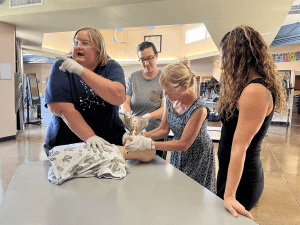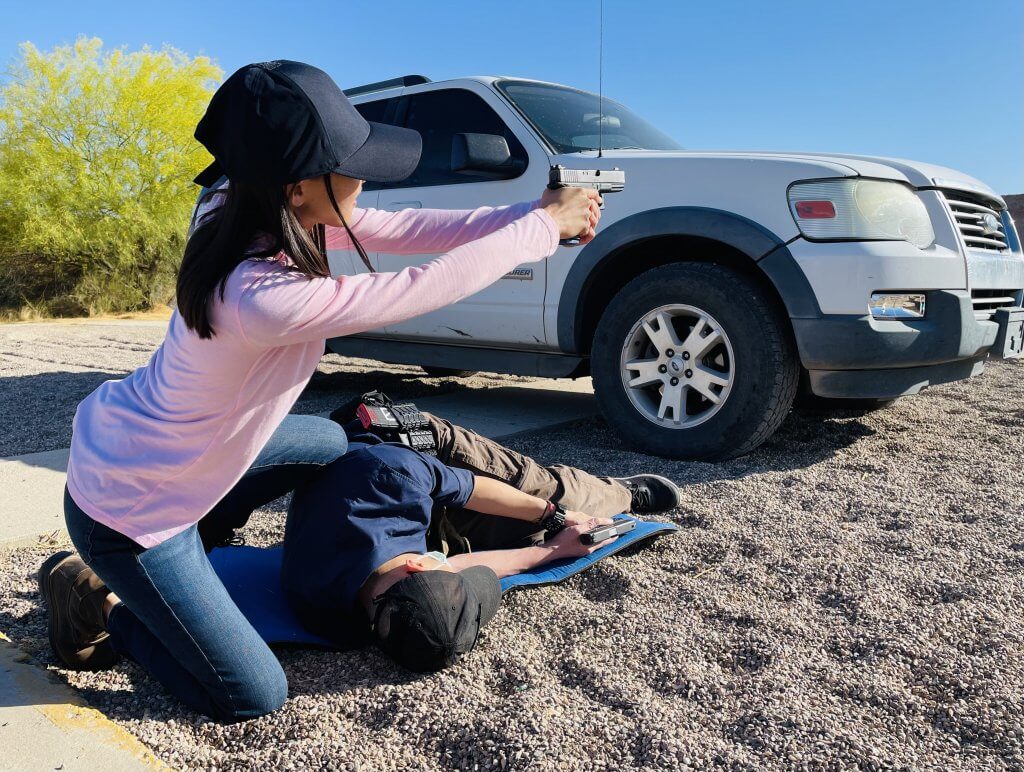The Neck Drag

Evacuating an Unconscious Patient from a Fire, or while Under Fire
If your patient is already passed out, you won’t be able to talk them into crawling out with you.
Crawling works best if you use all four limbs. It’s harder and slower if you’re using one limb to drag someone.

Soldiers needing to drag a wounded casualty while crawling to stay low behind scant cover or though a culvert use the Neck Drag.

First, tie the patient’s wrists together. It doesn’t need to be tight enough to hold them prisoner; it only needs to last till you get outside. It works best if they are tied with hands pointing in opposite directions (alongside the opposite wrist / forearm), rather than held together like “prayer hands.”

You can use a tourniquet. I try to always have a tourniquet nearby, but that won’t always be the case. Several students pictured here used sweatshirt sleeves to tie their role-player patient’s wrists. You don’t need to tie the wrists if the patient is awake and their arms work but their legs are out of action.

Hook the patient’s arms over your neck, with their back on the ground and you over them, facing down. Then crawl.

I call this method the “Stink Bug” because the dragger’s back end tends to come up off the ground. In some sports or PE classes, you may do “bear crawl” drills, which use similar positioning. You get more mechanical advantage that way–like sprinters about to leave the blocks–plus you don’t squash your patient. Soldiers taking fire from an enemy might stay lower, to keep from getting their tail end shot off, but in a structure fire, as long as your face is low to the ground–below the smoke–the rest of you is free to come up a little.

Practice the Neck Drag with your friends / family. Just be sure to shower and use mouthwash first.
–George H, Lead Instructor, Heloderm LLC

Appendix:
The Toxic Twins
The two biggest smoke inhalation killers in this synthetic era are hydrogen cyanide (HCN) and carbon monoxide (CO). Both are produced during fires. Both can be present even if you see no smoke or only a thin haze. Both are bad for you (the Nazis used HCN as part of their extermination program) but the two combined are far worse.
HCN is absorbed through the skin and the lungs but the lungs get it into the body faster. Both chemicals hitch a ride on your red blood cells (RBCs), taking the place of the oxygen that’s supposed to be there. A pulse oximeter (that clamp with the red light that they stick on on your finger) says your oxygenation is “XX%” (usually 95% to 99%)–but the pulse ox’ works by counting the RBCs, NOT by actually measuring oxygen. For hours or even days after a house fire, your pulse ox could look fine, but you might actually be dying of HCN + CO poisoning.
Two solutions:
- Go to a friend or relative’s house and take a cool or lukewarm shower as soon as possible (ideally within an hour) after escaping from a fire. If you wait a few hours, you will have absorbed much more through your skin. Using cool or at least not hot water keeps your pores closed so you don’t absorb as much before you can wash it off. If your family shoots guns recreationally, you should also shower with cooler water afterward to reduce lead absorption through your skin.
- After a fire, go to a hospital and get oxygen therapy, even if you feel fine. Breathing pure oxygen can help to displace the HCN / CO. There are even medicines that can convert the toxins into harmless chemicals you will pee out.
The Toxic Twins are the leading cause of heart attacks in the hours and days after a fire.

